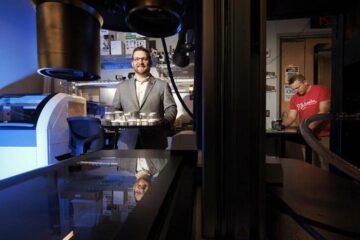Biomedical engineers at case develop first sliver-sized sensor to monitor glucose levels

It’s a good thing that the now eight-year-old son of Miklos Gratzl, a Case Western Reserve University biomedical engineer, got a splinter in his finger one day – at least for the sake of science. With apologies to his son – instead of an “Ouch!” moment, for Gratzl it was more of an “A-ha!” moment.
As he was removing it from his son’s finger, the splinter gave him an idea: Since it showed no open wound in the skin, he thought to himself that a sensor like a sliver would be ideal for all kinds of biomedical applications since the skin would heal very quickly above it and after that no track infection can occur.
The associate professor of biomedical engineering and researcher at the Case School of Engineering has developed for the first time a “sliver-sensor” – a fully functional, minimally invasive, microscopic new monitor that can be placed just under the skin and seen with the naked eye for very accurate, continuous examination of glucose level for diabetics and other bodily fluid levels – with the help of simple color changes.
Colors in the tiny sensor, which is smaller than the tip of a pencil, gradually change from orange (low glucose levels) to green and then to dark blue as levels increase. A deep, darker blue signifies the highest glucose level that can occur in diabetics. Gratzl and co-principal investigator Koji Tohda, a biomedical engineering researcher at Case, believe the implications for improving the quality of life of diabetics would be substantial.
“Many diabetics could greatly benefit from this technology, freeing them from having to take samples from their fingers several times a day to monitor blood sugar levels,” Gratzl said. “The monitor could also help doctors with close monitoring of electrolytes, metabolites and other vital biochemicals in the body, primarily those of critically ill patients.”
Gratzl and Tohda’s research also may benefit our future astronauts. The research is being funded by NASA and the John Glenn Biomedical Engineering Consortium at NASA Glenn Research Center, and partially by Vision Sensors LLC, a Cleveland-based startup.
Astronauts face the possibility of becoming ill while in space. Accidents also happen. In such cases doctors on Earth have to make a diagnosis from a distance of several thousand miles. This new sensor, continually monitoring such vital markers as ions and metabolites in an astronaut’s interstitial fluid may make it easier and quicker for doctors to decide the best intervention and therapy. To date, no such continuous, minimally invasive monitor for ions and metabolites has been available.
Tohda’s expertise in the area of optode technology helped point the researchers in the direction of using color changing molecules to detect ionic levels as they vary with changes in glucose. According to Gratzl, this approach is much more modern and powerful technology than the traditional color dyes, which are difficult to “immobilize” inside the sensor, Gratzl says. Traditional dyes tend to diffuse and “get lost” in tissue and cannot be changed or “tuned” to best adapt to being inside a sensor. So Tohda suggested they create a sliver sensor that would generate color change instead of an electrical current. “We also thought that color can be seen better from the outside if the sliver is not too deep, and if it gets distorted by the skin this can be corrected by using a white spot inside the sensor that does not change color,” Gratzl said.
The sensor, which is one to two millimeters long and 100 to 200 micrometers wide, penetrates the skin easily and painlessly so users may insert or reinsert it themselves when needed and can be operational at least for several days at a time. It can be monitored by eyesight and by electronic telemetry using a watchlike device worn by the person for data processing. Sensing itself does not require a battery, or the collection of blood samples, and needs very little energy if a watchlike signal processor is used. With no wires across the skin, there is no deterioration of the skin surface or other areas inside the skin and no danger of track infection. The device also is advantageous because no electrical currents are going through the body.
Gratzl says lab testing and in vivo testing of the sensor in laboratory animals has been going well. He also reports the sliver sensor could be ready for human testing within six months. “So far, the sensor is performing beyond expectation in preliminary laboratory tests,” Gratzl said. “Over the years, there has been a lack of good, quality devices for diabetics to monitor glucose – something they must do every day of their lives – devices that are reliable, relatively low-cost and minimally invasive.”
Members of the John Glenn Biomedical Engineering Consortium include Case, NASA Glenn Research Center, the Cleveland Clinic Foundation, University Hospitals of Cleveland and the National Center for Microgravity Research.
Media Contact
More Information:
http://www.case.eduAll latest news from the category: Life Sciences and Chemistry
Articles and reports from the Life Sciences and chemistry area deal with applied and basic research into modern biology, chemistry and human medicine.
Valuable information can be found on a range of life sciences fields including bacteriology, biochemistry, bionics, bioinformatics, biophysics, biotechnology, genetics, geobotany, human biology, marine biology, microbiology, molecular biology, cellular biology, zoology, bioinorganic chemistry, microchemistry and environmental chemistry.
Newest articles

Bringing bio-inspired robots to life
Nebraska researcher Eric Markvicka gets NSF CAREER Award to pursue manufacture of novel materials for soft robotics and stretchable electronics. Engineers are increasingly eager to develop robots that mimic the…

Bella moths use poison to attract mates
Scientists are closer to finding out how. Pyrrolizidine alkaloids are as bitter and toxic as they are hard to pronounce. They’re produced by several different types of plants and are…

AI tool creates ‘synthetic’ images of cells
…for enhanced microscopy analysis. Observing individual cells through microscopes can reveal a range of important cell biological phenomena that frequently play a role in human diseases, but the process of…





















